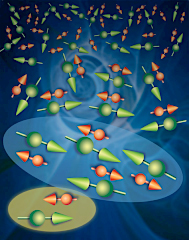
John DiTusa
Professor of Physics
Ph.D., 1992 - Cornell University
Louisiana State University
Department of Physics & Astronomy
202 Nicholson Hall, Tower Dr.
Baton Rouge, LA 70803-4001
225-578-2606-Office, 9105-Lab
ditusa@phys.lsu.edu
Research Interests
Experimental Condensed Matter Physics
 Magnetic materials that can be manipulated with the same control as present day electronic
materials based on silicon technology are required for future development of spintronics
and spin-based version of quantum computing. Spintronics has been coined to refer
to devices that make use of not only the charge properties of semiconductors and metals,
as in today's transistor based devices, but also of the carriers spin (intrinsic angular
momentum). We have focused our research on materials systems that may offer such control.
This includes silicon based magnetic semiconductors, germanides, oxides, and sulfides
where the carrier concentration and magnetic state can be controlled chemically or
with external pressure. In addition, an understanding of the properties of these materials
requires exploration of their low temperature properties. Since these materials are
typically near metal-insulating and non-magnetic to magnetic phase transitions the
physics of quantum phase transitions play a role in determining their low temperature
properties.
Magnetic materials that can be manipulated with the same control as present day electronic
materials based on silicon technology are required for future development of spintronics
and spin-based version of quantum computing. Spintronics has been coined to refer
to devices that make use of not only the charge properties of semiconductors and metals,
as in today's transistor based devices, but also of the carriers spin (intrinsic angular
momentum). We have focused our research on materials systems that may offer such control.
This includes silicon based magnetic semiconductors, germanides, oxides, and sulfides
where the carrier concentration and magnetic state can be controlled chemically or
with external pressure. In addition, an understanding of the properties of these materials
requires exploration of their low temperature properties. Since these materials are
typically near metal-insulating and non-magnetic to magnetic phase transitions the
physics of quantum phase transitions play a role in determining their low temperature
properties.
My research interests include: Magnetic semiconductors, quantum critical behavior in low carrier density materials, magnetoresistive materials and mechanisms of magnetoresistance, and quantum spin systems such as one-dimensional antiferromagnets which can be carrier doped.
Image above describes quantum critical physics of spin systems with temperature decreasing in the foreground. The green oval represents unpaired spin complexes responsible for the inelastic scattering which causes the non-Fermi liquid behavior. Light blue oval region demonstrates that the majority of the magnetic moments in the system are coupled into a singlet state.
Current and Select Publications
-
Cao G, Xie W, Phelan WA, DiTusa JF, Jin R. 2017. Electrical anisotropy and coexistence of structural transitions and superconductivity in IrTe2. Phys Rev B 95:035148. http://journals.aps.org/prb/abstract/10.1103/PhysRevB.95.035148
-
Dhital C, Khan MA, Saghayezhian M, Phelan WA, Young DP, Jin RY, DiTusa JF. 2017. Effect of negative chemical pressure on the prototypical itinerant magnet MnSi. Phys Rev B 95:024407. http://journals.aps.org/prb/abstract/10.1103/PhysRevB.95.024407
- DiTusa, J. F., Goodrich, R. G., Harrison, N., & Choi, E. S.,"Fermi surface of Ce1-xVx across the quantum critical point," Phys. Rev. B 82, 075114 (2010).
- Manyala, N., DiTusa, J. F., Aeppli, G., & Ramirez, A. P., "Doping a semiconductor to create an unconventional metal," Nature 454, 976-980 (2008).
- Capan, C., Jo, Y-J., Balicas, L. Goodrich, R. G., DiTusa, J. F., Vekhter, I., Murphy, T. P., Bianchi, A. D., Pham, L. D., Cho, J. Y., Chan, J. Y., Young, D. P., & Fisk, Z., "Fermi surface evolution through a heavy fermion superconductor-to-antiferromagnet transition: de Haas-van Alphen effect in Cd substituted CeCoIn5," Phys. Rev. B 82, 035112 (2010) [Editors’ suggestion].
- Guo, S., Young, D. P., Macaluso, R. T., Browne, D. A., Henderson, N. L., Chan, J. Y., Henry, L. L., & DiTusa, J. F., "Discovery of the Griffiths phase in the itinerant magnetic semiconductor Fe1-xCoxS2," Phys. Rev. Lett. 100, 017209 (2008).